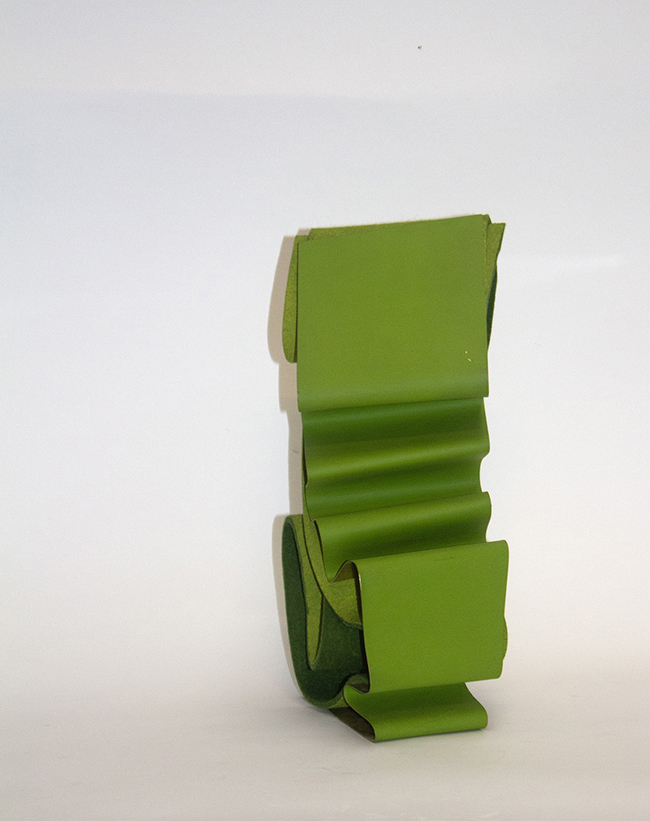Louise McRae’s artistic journey began amidst the rugged landscapes of New Zealand’s West Coast, where the interplay between nature and imagination shaped her early years. Her work reflects this deep connection to the environment, exploring the relationship between materials, forms, and the organic world. Through her sculptures, McRae delves into the fragility and resilience of life, capturing moments of transformation and the essence of living.

Louise McRae’s art is a testament to her fascination with materials and their inherent properties. She creates pieces that highlight the point of failure and resilience in materials, embodying the delicate balance between creation and destruction. This duality is evident in her series “Landscape Creatures,” which includes works like “Turning Green” and “Be Purple.”
In “Turning Green,” McRae uses brass, felt, and acrylic to create a dynamic sculpture that reveals its inner workings as the viewer moves around it. The use of brass provides a sense of solidity, while felt introduces softness, and acrylic adds a vibrant touch. The combination of these materials forms an organic structure that feels alive, inviting viewers to contemplate its intricacies. As McRae explains, “The paint is the structure, the skin holding the thing together.”

“Be Purple” employs copper, felt, and acrylic to achieve a similar effect. The copper lends a warm, earthy quality to the piece, while the felt and acrylic interplay to create a visual and tactile experience. McRae’s choice of materials and their interactions emphasize the organic forms she seeks to capture, reflecting the interconnectedness of life and land.
McRae’s work goes beyond mere aesthetics; it is deeply philosophical, questioning our relationship with the environment. She poses the question, “If we think of ourselves as part of the land, does it shift our way of being in the world?” Her sculptures invite viewers to ponder their connection to nature and consider how this relationship influences their existence.
This perspective is rooted in McRae’s belief that we are organic forms walking on land, intertwined with it on a microbial level. Her art challenges the perception of land as a separate entity, instead urging us to see it as an integral part of our being. This holistic view is woven into the very fabric of her sculptures, where the materials and forms are not just elements but active participants in a larger dialogue about life and existence.
For Louise McRae, the process of making art is akin to the process of living. She embraces the challenges and uncertainties that come with creating, seeing them as opportunities for growth and discovery. Her approach is characterized by curiosity and experimentation, where excitement often gives way to vulnerability. Yet, it is through this vulnerability that wisdom emerges, leading to works that resonate with intention and purpose.
McRae’s satisfaction comes from the alchemy of bringing all elements together, where the final piece sings with a harmonious blend of intention and material. This process mirrors the complexities of life, where disparate experiences and emotions coalesce into moments of clarity and understanding. Her art becomes a metaphor for the human experience, capturing the beauty and struggle of existence.
One of the striking aspects of McRae’s sculptures is their honesty. As viewers walk around her pieces, they uncover the hidden structures and layers within. This transparency reveals the complexity of the forms, inviting deeper engagement and contemplation. McRae’s work is not just to be seen but to be experienced, each angle offering a new perspective and insight.
This revelation aligns with McRae’s philosophy of art as a reflection of life. Just as her sculptures open up to reveal their inner workings, life too unfolds, exposing its layers and intricacies. McRae’s art encourages us to embrace this unfolding, to see the beauty in the process of becoming and the interconnectedness of all things.
Louise McRae’s art is a profound exploration of material, form, and philosophy. Rooted in the rugged landscapes of her youth and shaped by a deep connection to the environment, her sculptures capture the delicate balance of life. Through her innovative use of materials and her philosophical approach, McRae invites us to reconsider our relationship with the world around us. Her work is a testament to the power of curiosity, vulnerability, and the transformative potential of art, creating pieces that resonate with a timeless, organic wisdom.

